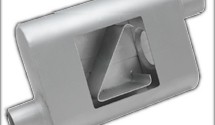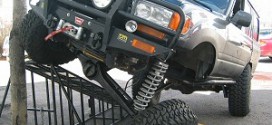 Electricity… it’s one of those things that you never think about until it stops working, then you wonder how you’ll ever survive without it. You flip a switch, the light comes on, you flip it again, the light goes out – you never even give it a second or even a first-thought.
Electricity… it’s one of those things that you never think about until it stops working, then you wonder how you’ll ever survive without it. You flip a switch, the light comes on, you flip it again, the light goes out – you never even give it a second or even a first-thought.
Your driveshafts probably fall into that same category with you too – you never give them a second thought. Other hip stuff like your high performance engine, the bright color of your rig, or maybe your new, big tires steal the spotlight for one reason or another. But, just like electricity, when your driveshaft fails you, you wonder how you’ll ever survive without it.
This tech article will teach you how to prevent your driveshaft – and differential gears too, actually – from attaining that dishonorable 15 minutes of glory by correctly clocking (rotating) your axles.
Key assumptions:
1)You have a reason to clock your rear axle (i.e. you’ve lifted your rig, you’re changing to a CV-type drive shaft, etc.)
2)You’ll be clocking your solid rear axle
3)You have some fabrication skills and access to some special tools like a welder, torch, grinder, etc.
4)You have a fundamental understanding of geometryTools you’ll need:
magnetic angle finder, torch, right-angle grinder, measuring tape, welder, vice grips, torque wrench, assorted sockets/wrenches, etc.
Before we begin this article, we would like to introduce you to a driveshaft UJoint system called the CV Joint (a.k.a. Double Cardan). Most of you gear heads are probably thinking about skipping this paragraph, but I’ll bet that if you keep reading, the vast majority of you will learn something new. There are variations on the CV Joint theme, but most often this is a dual set of UJoints connected together buy a specialized component. There is a wide spread misconception about CV Joints that you should be aware of. This misconception is that it will allow for greater operating angles than a conventional 2 joint or single cardan drive shaft – NOT true – in fact, some types of CV joints will actually incur a binding interference at less of an angle than a standard two-joint drive line, again depending on the individual components used. Additionally the CV joint itself is longer than more conventional components and will create a greater operating angle on the driveline, especially on very short shafts. This isn’t always the case as there are specialized, high-angle CV joints available. The true benefit of a CV joint is that it will deliver smoother operation at higher operating angles and at higher speeds, and offer longer life than a standard single cardan setup. The C.V. assembly works by intersecting the joint angles at the center pivot point and delivering a smooth rotational power flow or surface velocity through the drive line. Did you learn something?
Now, with that out of the way, let’s clock that axle of yours…
For this article, we’ll assume that you’ll only be clocking your rear axle, and that it is not an IFS axle and that it does not have rear wheel steering. Clocking an IFS axle can certainly be done, but in a very different way. Further, clocking a front or rear steerable axle adds the complexity of steering geometry by changing its caster (we’ll save that for yet another tech article). Lastly, this article is written towards leaf sprung axles, but the axle clocking is primarily the same for coil sprung axles, just replace “spring perch” references with “coil bucket”.
|
The first step is to prep your vehicle and take measurements – lots of measurements. Start by cycling the suspension for several minutes to get it settled into place.You can do this by jumping up and down vigorously on the back of your rig. This is one of those simple steps typically forgot by those who clock their axles, only to find that their driveline angles change later. |
TWO TYPES OF DRIVELINE ANGLES:
CV Joint Drive Shaft: The generally accepted drive line angle for a double-cardan driveshaft is zero degrees. In essence, the axle pinion should be pointed roughly AT the output shaft of the transfer case. Or, said another way, a near zero degree difference between the pinion angle and the driveshaft angle.
Single Cardan Drive Line: The generally accepted drive line angle for a single-cardan (standard driveshaft) is negative 2 degrees (down) from the plane of the rear axle pinion and the plane angle of the engine/transmission/TCase combination. Or, said another way, the pinion angle should be roughly 1 to 2 degrees down from the same angle as your engine/transmission/TCase, which will allow it to rotate up slightly, due to engine torque.
While the driveline type (CV or standard) is irrelevant for this article, our axle drive line uses a CV Joint driveshaft.
Your next steps to finish prepping the vehicle includes disconnecting the negative lead (ground) from the battery, securing and chocking the front tires, and jacking the rear-end of the rig by the axle and the rear bumper with a floor jack and jack stands. If you’re suspension system is a spring-over style, then support the rig by placing the jack stands underneath the axle tube. Transversely, if your suspension system is spring-under, then support the rig by the frame or the bumper AND the axle. With the vehicle prepped and secured, start by completely removing the leaf springs. Next, take several measurements of the placement of the existing spring pads (a.k.a. spring perches). Take your time and triple check your spring pad locations. It’s crucial that the new perches are mounted in the same locations (in a horizontal plane) later. We used the backing plates of our drum breaks as our starting point and measured the distance between that and the outside of the spring pad. You can use any other outer surface to (i.e. disc brakes, calipers, etc.) to make your measurements, as long as it is completely symmetrical. |
NOTE: If your new spring perches are not the same width as the old perches (either by purpose, or by accident), then you’ll need to figure out the net difference in width and apply that to your measurements, so that your new perch is correctly centered. This normally shouldn’t be the case, but if so, follow the mathematical guidelines below. Also, if your new spring perch is wider, you’ll likely need to adjust your U-Bolt width as well, so, when you order your perches, make note of their width.
Example:
Old spring perch:
2” Wide, 6” from backing plate to inner edge = 5” centerNew spring perch:
2.5” wide, 6 ¼” from backing plate to inner edge = 5” center
Technical Sources
| Tom Woods Custom Drive Shafts |
| 2147 N. Rulon White Blvd. Building #1 Suite #103 Ogden, UT 84404 Phone: 1-877-4xShaft (1-877-497-4238) Fax: 1-877-4xJoint (1-877-495-6468) Web Site: www.4xshaft.com |
 4x4Review Off Road Magazine
4x4Review Off Road Magazine





